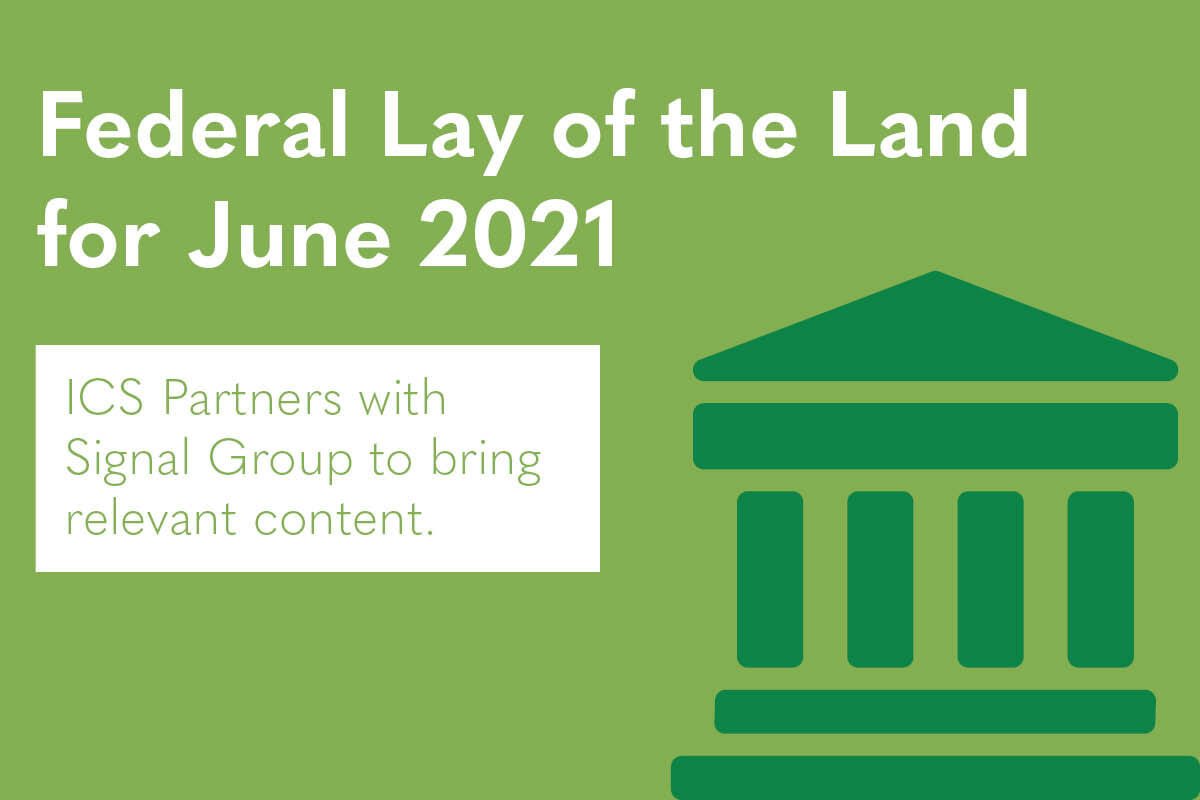
In collaboration with Signal Group, here’s the Federal Lay of the Land for June 2021. For more information, please reach out to Dave Bergeron at dave.bergeron@ics-builds.com.
Economic Markers
- Gross Domestic Product: The latest data from the Bureau of Economic Analysis estimated that the U.S. GDP grew at an annualized rate of 6.4% in the first quarter of 2021 – fueled by government stimulus, the re-opening of businesses, and an increased pace of vaccinations. This updated second estimate of Q1 data was released on May 27 and confirms earlier predictions that real GDP had recovered to 93% of its pre-pandemic levels as of the end of March 2021. BEA will release an updated third estimate of Q1 data on June 24. This update will include a breakdown of GDP by industry.
- Unemployment: According to data from the Bureau of Labor Statistics, unemployment fell by 0.3 points to 5.8% in May from 6.1% in April. While this figure continues to decrease, it is still far above its pre-pandemic level of 4.5% in February 2020. The unemployment rate for the construction industry has improved significantly in recent months and is now closing in on the overall rate across sectors. As of May 2021, it is 6.7%, down 1 point from 7.7% in April 2021 and up 1.2 points from its pre-pandemic level of 5.5% in February 2020. BLS will release June’s unemployment report on Friday, July 2.
- Inflation Concerns: As negotiations on high-dollar infrastructure spending ramp up on Capitol Hill, the Federal Reserve, Treasury Department, and leading U.S. economists are discussing the implications of this spending and the return to normal life on the health of the economy.With the Fed likely to hold the interest rate near-zero through 2024, many economists, including former Treasury Secretary and National of Economic Council Director Larry Summers are warning of the possibility of runaway inflation. Others, including Treasury Secretary Janet Yellen, are saying that modest inflation and interest rate increases may be beneficial and will not likely have harmful long-term effects.In May, Goldman Sachs forecasted a 3.6% April increase in Consumer Price Index (CPI), 0.6% below the actual surge of 4.2% during the month. Goldman’s Chief Economist Jan Hatzius attempted to allay concerns about the underestimation, maintaining that these near-term inflationary pressures are transitory in nature, and not indicative of long-term harmful trends. The latest report from Hatzius’ team revised its CPI predictions to 3.5% for 2021 and 2.7% for 2022, up by 1.25% and 0.33% respectively from their May estimates.
- Supply Chain Concerns: Booming demand and diminished supply for building materials during the pandemic, particularly in lumber and steel, have led to significant supply shortages. According to the National Association of Home Builders (NAHB), lumber prices are up nearly 250% from their low in April 2020. Similarly, steel prices are up 270% from when they bottomed out in August.With these supply chain issues driving price spikes at a time when President Biden is proposing multi-trillion-dollar infrastructure investments, the Department of Commerce is under pressure to make difficult decisions regarding tariffs. The administration is navigating the need to corral prices with President Biden’s pledge to support American labor. Both the U.S. Lumber Coalition and the Steel Manufacturers Association have sent letters strongly urging the administration to keep tariffs in place.
The American Rescue Plan
On March 11, President Biden signed the $1.9 trillion COVID-19 relief package – the American Rescue Plan – into law, including $122.7 billion in ESSER III funding for K-12 schools, with eligible uses of funds left intentionally broad. Further, the legislation also authorized $350 billion in emergency funding to state and local governments, allowing states and localities to aid a range of entities.
- Flow of ESSER III Funds: The first two-thirds of funds – approximately $81 billion – were released in March by the Department of Education to State Education Agencies (SEAs). Upon receipt of funds, SEAs were given 60 days to make funds available to Local Education Agencies (LEAs). By the end of May, all LEAs should have become able to apply to their SEA for their portion of this $81 billion via a subgrant.The final one-third of ESSER III funds – approximately $41 billion – is predicated upon states submitting plans to the Department of Education outlining their use for these funds. In their plans, states will be required to demonstrate that states and school districts are adequately engaging with the public to determine areas of greatest need. States will also need to show how they are making uses of funds transparent and compliant with ESSER requirements.While the Department of Education has not yet released a specific timeline for the release of this final tranche of funds, it has said it will be ‘approving applications and disbursing funds expeditiously once plans are received and reviewed.’ State plans were due to the Department on June 7.LEAs that receive ESSER III subgrant funding from SEAs have until September 30, 2024 to obligate all funds.
- Flow of Emergency State and Local Government Funds: On May 10, the Department of Treasury released its first round of the $350 billion in relief payments to state and local governments authorized by the American Rescue Plan. Treasury has left eligible uses for these funds intentionally broad, including for expenditures related to economic recovery and infrastructure investment.
- Most state and local governments will receive the first 50% of this funding in two separate payments – the first in May or June, and the second 12 months following the first. Governments in states with an unemployment rate that is more than 2% above pre-pandemic levels will receive 100% of their funding with the first payment. 18 total states, including Pennsylvania, meet the threshold for this special accommodation.
The American Jobs Plan
The Biden Administration and Congress are engaged in slow-moving talks over an infrastructure package. President Biden has aimed to find a bipartisan pathway to passing elements of his Build Back Better infrastructure framework, particularly his American Jobs Plan, which proposes spending $2.25 trillion over 8 years in areas like transportation, clean energy, broadband, and public buildings. The AJP proposes key school infrastructure investments including:
- $50 billion in grants and $50 billion in bonds for K-12 infrastructure
- $12 billion in grants for community college infrastructure
- $45 billion to eliminate the nation’s lead pipes, including in an estimated 400,000 K-12 schools and childcare centers
Some Republicans have been willing to come to the negotiating table, most notably a group of 6 GOP Senators led by Sen. Shelley Moore Capito (R-WV), the top Republican on the Senate Environment and Public Works Committee. The group released a counteroffer to Biden’s proposal on May 27 – a $900+ billion package that notably does not propose school infrastructure funding. Discussions between Capito and Biden turned sour on June 8 and both sides are now back to square one. Negotiations will pick up soon, but the fragility of these talks is a testament to the major hurdles that must be overcome to achieve bipartisan consensus on an infrastructure package.

